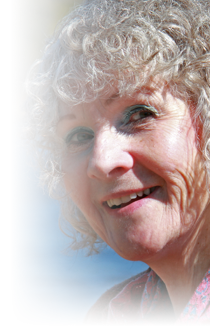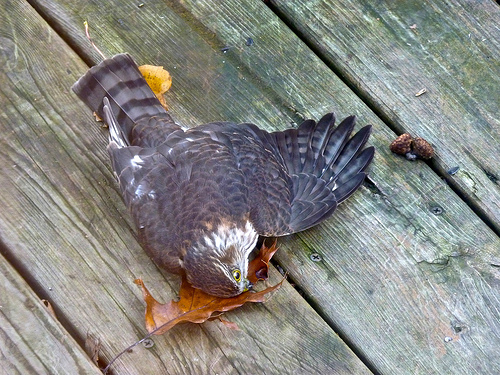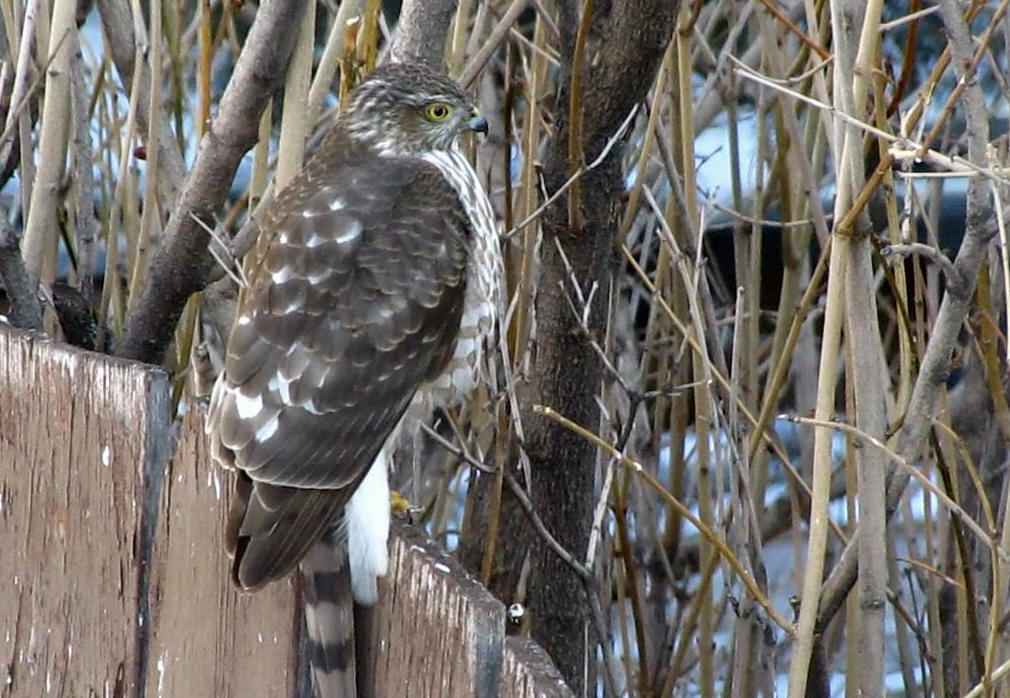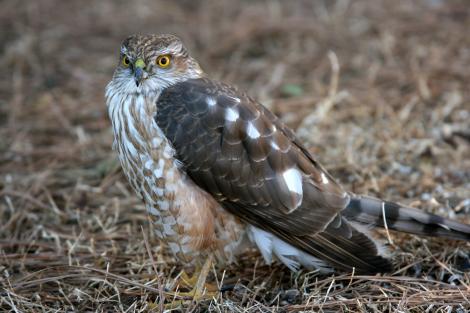 I heard a loud whump, and ran to the back room of my farmhouse. The splat on the window indicated a bird had hit it. Opening the side door, I gazed upon the spread wings of a bird laid out on the porch floor. Oh my God, was it dead or alive? Quickly putting on boots and gloves, I approached the bird and saw his head twitching. Removing the gloves, I spoke softly and applied therapeutic touch over the body. I gently lifted one wing, and dislodged the bird’s talons – very impressive – from the wet snow underneath. What I later identified as a juvenile sharp-shinned hawk gingerly stood up, but did not change position for several more minutes. His head darted in all directions, as I backed up. Stepping forward again, the hawk hopped away from me, then stopped, so that I disappeared indoors, still worried whether a wing had been broken. But, blessedly, through the window, I then saw it perched on the porch railing. Noticing it gone a few minutes later, I stepped outside, and heard a rustle from a nearby bush, followed by the hawk emerging for a low flight across the pasture.
I heard a loud whump, and ran to the back room of my farmhouse. The splat on the window indicated a bird had hit it. Opening the side door, I gazed upon the spread wings of a bird laid out on the porch floor. Oh my God, was it dead or alive? Quickly putting on boots and gloves, I approached the bird and saw his head twitching. Removing the gloves, I spoke softly and applied therapeutic touch over the body. I gently lifted one wing, and dislodged the bird’s talons – very impressive – from the wet snow underneath. What I later identified as a juvenile sharp-shinned hawk gingerly stood up, but did not change position for several more minutes. His head darted in all directions, as I backed up. Stepping forward again, the hawk hopped away from me, then stopped, so that I disappeared indoors, still worried whether a wing had been broken. But, blessedly, through the window, I then saw it perched on the porch railing. Noticing it gone a few minutes later, I stepped outside, and heard a rustle from a nearby bush, followed by the hawk emerging for a low flight across the pasture.
The message here is, care enough to take action in the moment, before it is too late. Doing so requires being tuned in sufficiently to one’s immediate environment to heed an unexpected or unusual sound or visual image, and be willing to investigate – fully.
Look at the photo below of a similar yet different fallen sharp-shinned juvenile hawk. The photographer (see Postscript) relates that he recognized it was alive, did not disturb it, and was delighted to see it fly away an hour later. My hawk was cushioned in a bed of snow, and needed remedial attention immediately.
If I had ignored the initial `whump’ or peeked out the side door, and assumed – wrongly – that the bird was dead before checking more closely, yes indeed, the bird would have died, its talons stuck, and soon frozen, in the deep, wet snow. This incident is not the first time that I have been vigilant, and caring enough, to rescue a bird and save its life from an unnecessary premature death.
Another pertinent lesson that I have been reminded about in recent weeks, however, raises the question, how vigilant are we about our own self-care? For those of us who are passionately committed to advocacy for social and environmental justice (and other significant issues) in the larger world, and/or overwhelmed by the constant call of care-giving loved ones, one’s own well-being can be pushed aside as the lowest priority.
A recent diagnosis of cancer radically changed my own worldview 180 degrees away from focusing too much on all of the woes in the world, as well as a list of regrets of what had transpired through life to cause me endless sorrow. Worse, I recognized how profoundly I had succumbed to chronic anxiety which almost entirely snuffed out joy in being alive at all, thus becoming unconscious to life in the moment.
The impact on the hawk of the unforeseen whump on the window could be a metaphor for the aftermath of the whump on my consciousness in hearing the initial diagnosis of malignant melanoma. Such a transformative moment changes everything forever, initially entering the body and feelings, before registering in the mind.
I blessedly can add, however, that the speedy actions of, respectively, my family doctor, a dermatologist, then a plastic surgeon, within a month of my doctor first seeing the unusual mole on my arm, followed by two biopsies, resulted in all cancer successfully cut out. Mind you, I had not bothered to show the doctor this mole through many months, so that I am darn lucky, because I sure had the crap scared out of me early last December.
This blog post is my way to process what has led to a more awakened perspective. I write it in the spirit of encouraging other helping professionals, volunteers and caregivers to avoid similar pitfalls. Please take time to reflect on your respective patterns that could undermine your own well-being.
The lessons for me are not to dwell on past disappointments or future uncertainties, any of which can paralyze us with anxiety and fear. Moreover, I had driven myself last year in efforts to revive my professional profile; but, at what cost is the question to address.
Most important – as I have relearned – is to cherish life in the moment, even as we contend with existing circumstances that are not pleasant or easily acceptable, such as chronic health issues and financial hardship.
We all have vulnerabilities, sometimes exposed through encountering unexpected dangers, and other times when previous traumas are reawakened through how others treat us.
Vulnerability resides in patterns of anxiety rooted in past traumas and subsequent projections of anxiety into the future, not to mention very real currently existing sources of stress – singly or collectively – which can overwhelm us. Transcending them is easier said than done. Yet transcend them we must.
Consider the young hawk’s vulnerability, slamming into an unexpected window. If another caring creature had not arrived on the scene, the hawk could have become lunch for one of my neighbour’s several barn cats who prowl the area.
If I had not been held in the embrace of my circle of friends in Toronto where I had agreed – synchronistically it seems – to house sit throughout the holiday season, I could have remained in a precarious condition of health, mentally and emotionally – between the second biopsy and the lab report’s findings two weeks later.
Therefore, critical moments of intervention are valuable, even life-saving.
Nevertheless, when we feel flattened, or stunned by an unexpected event – even while graced with the caring support of one or more intervenors – it still, ultimately, is our own responsibility in choosing either to give up or rise up to take the next step. Those who care about us only can provide encouragement, compassion and love, but the ultimate choices in our pathway forward in life are ours alone.
Note the young hawk whom I encountered (similar to photo above). He bounced up, next pausing several times as he surveyed the surrounding landscape, choosing to walk forward, step-by-step, with interludes of stillness and reflection. How regularly do our choices include such interludes, in regard to reflecting on our inner landscape and how we respond to outer world challenges?
Granted, the hawk’s initial stillness was the obvious consequence of being stunned from hitting the window. Similarly, I felt stunned from the initial diagnosis of cancer, and floated through several days in a mental fog after the news.
Stillness and reflection, admittedly, have been mostly absent from my life in recent years, particularly during the year 2015. Last year was bookmarked by two personal health scares. Between them I drove myself relentlessly in nonstop mental productivity, culminating in the worst burnout experienced in many years this past autumn, prior to the diagnosis of cancer.
Ignoring the signs of accumulating effects of overwork on mind, body, and emotional state had been a lifelong habit that I thought I had kicked.
The year 2015 originally had held much promise in opportunities to pull together the major themes of decades of professional and volunteer work, in writing, facilitating workshops, and oral public presentations.
These interwoven themes include how and why to deepen understanding across cultures – specifically Indigenous vis a vis Euro-western cultures – as well as deepen understanding of the wounded soul, universally, through the perspective of spiritual psychology. The third theme on human consciousness, added in more recent years, connects the outcomes of human actions to the plight of all planetary life. My quest now is to illustrate how such patterns can, and need to be, transformed to heal and restore our humanity and, as well, treat the planet’s life support system with more respect and intelligence.
Consequently, after recovering from painful chilblains on my feet as a result of a broken furnace through several weeks of 2015’s beginning months – and even through that discomfort, writing conference presentation proposals for deadlines – I continued to feel as driven as a freight train, to make up for lost time.
Indeed, like a freight train under a tight schedule, I felt constantly under pressure to meet a series of deadlines, rushing to unload freight at each station as well as piling on more freight before continuing on the route of obligatory stops. the nonstop demands became overbearing and, worse, the freight carried was too heavy for the train’s engine to keep running at its optimum.
Here, metaphorically, the freight that sorely burdened my inner train engine was continual research and organizing of data to rework into coherent presentations, endlessly loading up research and packaging data, to deliver it for each and every deadline. Pushed to the limit, my engine was brought to an abrupt halt caused by total mental exhaustion.
Meeting my `Waterloo’ was the end point reached not just from creative, joyful commitments in 2015. But, while busy in the transformative work that usually regenerates me, as does receiving the acknowledgment of peers, something else much less rewarding was burning out my engine.
From spring through to early autumn was moral pressure – self-imposed – to challenge the numerous flaws in the Joint Review Panel (JRP) environmental assessment report published May 6, 2015, regarding a proposed deep geologic repository (DGR) next to Lake Huron. The report, incredulously, approved the DGR to receive a licence to go forward.
Our small coalition of local citizens in Bruce County had devoted months out of our lives through three years, and counting, to bring forward independent research and intervene at two public hearings, as did longstanding environmental organizations, and independent scientists. We all felt betrayed, because our research was co-opted (when not dismissed entirely) by the JRP to create almost 100 recommendations for mitigations (yet unproven to be effective) if something goes wrong. By then it is too late, once radionuclides are released into the environment. To proceed with a DGR is morally irresponsible.
Therefore, we also felt outraged, and propelled to continue the fight, the newly elected federal Minister of Environment now making a decision on March 1, 2016 – a decision that might well be challenged.
Analyzing more than 500 pages of the JRP report to submit an informed written submission to the federal government, by end of August 2015, was no small feat, particularly sandwiched between other deadlines on more pleasurable work. Nevertheless, I am like a terrier with a bone when I take on a cause, moral fortitude and sheer persistence pushing through every obstacle like a bulldozer.
My ultimate goal, to fight against this abominable nuclear waste dump, is to produce a book in 2016. I pumped out two writing grant proposals, the larger one requiring a 40-page manuscript double spaced, for a mid-October 2015 deadline. (That followed completing a major essay on an Indigenous theme for end of September, to be considered for publication later in 2016.)
By end of October, I was blotto, inner fuel tank empty and burned out.
In Toronto through the holiday season, aside from seeing friends, I thought I could cope again, to work on a 6,000-word essay, due end of January 2016, on “honouring the sacred feminine.” No, I am not a masochist, just a bit dim at times. I was oblivious – until a couple of friends read me the `riot act’ about self-care – to the negligence I perpetrated upon my own inner `sacred feminine,’ basically my very life force.
Thanks to (how many?) interventions since last August, I rediscovered the meaning of the verb, “relax.” I stayed off a computer in Toronto except for scheduling social dates, and emptied my mind from as much left-brain thinking (analysis) as possible.
What I have relearned is a reminder why I relocated from the city to a modest homestead in the countryside, choosing a lifestyle of voluntary simplicity to restore health previously broken from overwork, and because my soul cried out for inner peace. I also knew that my intellectual mind needed a retooling to wind down.
The tools needed to restore balance within each human being and, indeed, collectively in human society today, are not based on technological fixes. We instead need to relearn how to connect with the earth and the always accessible lessons from the world of Nature when our heart and soul awaken. The choice always is ours to listen up.
The beautiful, powerful, yet also vulnerable, hawk illustrates the qualities in all of us, when we pay attention. We human beings are biological creatures, yet susceptible to living out-of-balance, and inflicting the consequences of that mindset on all other forms of planetary life today, so painfully evident in climate change and extreme weather.
Whether we learn sufficiently as a human species to restore more balance in our own lives – overburdened in the developed world by so much ridiculous, and unnecessary, artificial baggage and materialism, with the subsequent self-induced stress and disconnectedness to what really matters – is an open question.
Doing so begins in the heart and soul of each and every person, when we can listen once again to those inner voices and not give all the power to the intellectual mind which is not adequately equipped in itself to assess the root causes, beyond merely the symptoms, of the challenges of survival we now confront.
Always, always, I am so grateful to be alive, when I open myself to the beauty and joy around me in each moment. All it takes is stillness and reflection, and the grace and humility to be thankful for everything that sustains life, and to learn from Nature’s messengers.
May the Creator bless that dear young hawk, a messenger who inspired me to communicate once again what really matters – caring, presence and love.
POSTSCRIPT:
Photo of hawk laying on porch found on Flickr, taken by normanack
Photo of hawk on fence found on BIRDS CALGARY, taken by Bob Lefebvre
Photo “Alert Baby Hawk” found on another website, photographer unidentified



